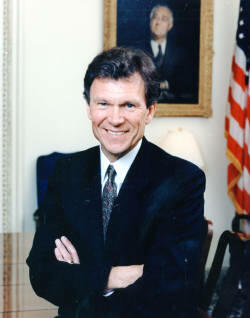The Personal Papers are composed of materials Daschle separated from the rest of the collection which were of personal interest to him. Included are pre-congressional materials, campaign records, legislative records, correspondence, political records, media files, and files saved for their intrinsic value.
Daschle, ThomasIn the 1986 election, Daschle became South Dakota's junior senator by winning 52 percent of the vote in a tight race with Republican Senator James Abdnor. Senator Daschle was appointed to the Finance Committee during his first year in the Senate, an unusual honor for a freshman. In 1988, he became the first South Dakotan ever to hold a Senate Leadership position when he was named the first ever co-chair of the Democratic Policy Committee by then Senate Majority Leader George J. Mitchell.
When Senator Mitchell retired in 1994, Daschle ran for the post of Democratic Minority Leader and won, 24-23, over Senator Christopher Dodd. Only Lyndon B. Johnson had served fewer years in the Senate before being elected to the Leader position.
Senator Daschle served as Minority Leader from 1994 to 2001, when the Senate became deadlocked with 50 Democrats and 50 Republicans for the first time in the Senate's history. Daschle became Majority Leader for 17 days, from January 3 to January 20, because the new congress took office before a new presidential administration. Vice-President Al Gore acted as ex officio President of the Senate to give the Democrats a majority.
Daschle and Trent Lott, the Republican Leader, negotiated for five weeks to invent new rules to share power in an evenly-divided Congress and finally came up with an agreement that was passed unanimously by the Senate. In May of 2001, Republican Senator Jim Jeffords became an Independent, which gave the Democrats a majority in the chamber to make Senator Daschle Majority Leader once again, from June 6, 2001-January 3, 2003. After the 2002 election, Daschle again became Minority Leader for the 108th Congress until his defeat in the 2004 election.
Tom Daschle lost the 2004 election to John Thune by 4,534 votes, a 49%-51% margin. He had been the Democratic Leader for ten years, two years longer than Lyndon B. Johnson, and was the first party leader in a half-century to be voted out of office.
The U.S. Senate papers series of the Daschle Papers is composed of records created by Tom Daschle and his staff during his tenure in the U.S. Senate. Included are trip schedules, speeches, sponsored and cosponsored legislation, and administrative files including financial disclosures, appointments and schedules. This series does not contain much material related to Daschle's campaigns for voting records during this time.
The trip schedules and files regarding his frequent trips back to South Dakota, including quite a few of Daschle's "Trip Notes" which are Daschle's notes to his staff regarding his impressions of the details of the trip and issues and concerns encountered on the trips that he wanted his staff to address.
Also included are files on the Whitewater issue during the Clinton administration, veterans issues, Ellsworth Air Force Base, South Dakota Water Projects, the accident of South Dakota Governor Mickelson, and aviation issues."
Daschle, ThomasTIn 1978, Daschle was elected to the United States House of Representatives, winning the race by a margin of 110 votes, following a recount, out of more than 129,000 votes cast. Daschle served four terms in the House of Representatives and quickly became a part of the Democratic leadership.
At the 1980 Democratic National Convention Congressman Daschle received 10 (0.30%) delegate votes for Vice President of the United States. Although he was not a candidate, Daschle (along with others) received votes against incumbent Walter Mondale, who was re-nominated easily.
he U.S. House of Representatives papers is composed of some campaign files and voting record information. Also included is "The Daschle Record" which contains 12 books compiled by his staff containing Daschle's voting record, sponsorships, and summaries of committee and subcommittee records from 1979 to 1986.
Due to the size and scope of the Daschle collection this collection was minimally processed. This means that material was placed in acid-free folders and containers, but processing at the item level was keep to a minimum. Only folders that had little or no description were looked into with more depth. Artifacts, such as plaques, framed items, textiles, art, and other three-dimensional items, were separated and placed in appropriate storage. Photographs were also separated and placed in proper storage containers.
Dates for each folder were chosen on what could be quickly ascertained. The dates are meant to give researchers a general idea of the dates of the material that is in each folder. These dates were selected on what could be quickly ascertained. If there was a range of dates covering material, then the earliest date was chosen.
Daschle, Thomas

